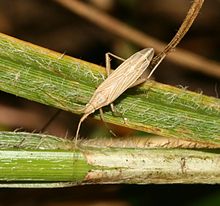Stenodema calcarata
| Stenodema calcarata | ||||||||||||
|---|---|---|---|---|---|---|---|---|---|---|---|---|

Stenodema calcarata |
||||||||||||
| Systematics | ||||||||||||
|
||||||||||||
| Scientific name | ||||||||||||
| Stenodema calcarata | ||||||||||||
| ( Fallén , 1807) |
Stenodema calcarata is a type of bug from the family of soft bugs (Miridae).
features
The bugs are 6.8 to 7.9 millimeters long. The species of the genus Stenodema have an elongated body and have a longitudinal pit between the compound eyes . The roughly and densely dotted pronotum is characteristic . Stenodema calcarata can be identified by the two spurs, one small and one large, curved, on the thighs ( femora ) of the hind legs and can thus be distinguished from Stenodema trispinosa , which carries three spurs. In autumn, the initially green adult bugs turn yellow-brown, whereas the females turn green again after hibernating. The darker colored, brown males hardly change their color. Occasionally there are also reddish colored individuals.
Occurrence and habitat
The species is widespread in large parts of the Palearctic . It occurs from North Africa and Europe through Asia Minor and the Middle East to China, Japan and Korea. In Central Europe the species occurs frequently everywhere. The species prefers moist habitats and lives on slightly damp to wet grass locations such as low and raised bogs, silting areas, wet meadows, on the banks of water bodies, hay meadows and extensively used pastures. Occasionally they are found in small numbers in dry places. In summer they are more likely to be found in open, less shaded places, in autumn more in shady places.
Way of life
Stenodema calcarata lives on grasses such as red bentgrass ( Agrostis tenuis ), Meadow Foxtail ( Alopecurus pratensis ), fescue ( Festuca ) and moors around on blue moor grass ( Molinia caerulea ) and many other grasses (Poaceae), but also to sour grass plants ( Cyperaceae) and rushes (Juncaceae), such as sedges ( Carex ), ledges ( Scirpus ) and rushes ( Juncus ).
There is only one generation per year in Scandinavia and the British Isles. In large parts of Germany there are two; only in unfavorable conditions, for example in high altitudes or in extreme locations such as in raised bogs, it is probably only one generation. Where two generations occur, the overwintering adults stab their eggs from mid-May to mid-June, preferably in the ears that have not yet developed. The adults of the new generation appear from late June to early August and lay theirs in August. The adults of the second, overwintering generation appear from September, but nymphs can still be encountered until October . Wintering takes place in the dry litter or in grass groves at the edge of the forest or in light deciduous and coniferous forests. It should also take place on conifers such as spruces ( Picea ). While looking for suitable winter spots, the bugs sometimes cover longer distances.
supporting documents
Individual evidence
- ↑ a b c d e Ekkehard Wachmann , Albert Melber, Jürgen Deckert: Bugs. Volume 2: Cimicomorpha: Microphysidae (lichen bugs), Miridae (soft bugs) (= The animal world of Germany and the adjacent parts of the sea according to their characteristics and their way of life . 75th part). Goecke & Evers, Keltern 2006, ISBN 3-931374-57-2 , p. 142 ff .
- ↑ a b Ekkehard Wachmann : Observe bugs - get to know . Neumann-Neudamm, Melsungen 1989, ISBN 3-7888-0554-4 , p. 228 .
- ↑ Stenodema calcarata. British Bugs, accessed July 4, 2015 .
literature
- Ekkehard Wachmann , Albert Melber, Jürgen Deckert: Bugs. Volume 2: Cimicomorpha: Microphysidae (lichen bugs), Miridae (soft bugs) (= The animal world of Germany and the adjacent parts of the sea according to their characteristics and their way of life . 75th part). Goecke & Evers, Keltern 2006, ISBN 3-931374-57-2 .
Web links
- Stenodema calcarata in Fauna Europaea. Retrieved July 4, 2015
